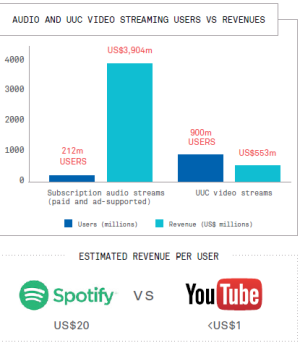A we reported, global streaming revenue was up 60% in 2016, according to the International Federation of Phonographic Industries (IFPI) annual report. Streaming revenue nudged the industry upward as a whole.
 Within that good news, a centerpiece of the report is an analysis of the “value gap,” which the IFPI defines as “the growing mismatch between the value that user upload services, such as YouTube, extract from music and the revenue returned to the music community – those who are creating and investing in music. The IFPI calls that disparity the biggest threat to the future sustainability of the music industry.
Within that good news, a centerpiece of the report is an analysis of the “value gap,” which the IFPI defines as “the growing mismatch between the value that user upload services, such as YouTube, extract from music and the revenue returned to the music community – those who are creating and investing in music. The IFPI calls that disparity the biggest threat to the future sustainability of the music industry.
The IFPI’s bottom line is this: For every $20 that Spotify contributes to the record industry through music royalties, YouTube contributes less than one dollar, by IFPI calculation.
The core problem, in IFPI’s estimation, is “misapplication of ‘safe harbours’.” Safe harbo(u)r is a legal term which specifies the terms and processes by which a user upload platform like YouTube is is held blameless for unauthorized uploads that infringe copyright. Generally, safe harbor defines a general operating procedure for qualifying platforms, and a process for acting on infringement complaints from rights-holders.
In the U.S., the IFPI specifically calls out the Digital Millennium Copyright Act, a 1998 law which defines American safe harbor law. The IFPI calls the law “one of the biggest problems confronting songwriters and recording artists today.”
In Europe, a thousand music artists (including Paul McCartney, Stings, and Coldplay), signed a letter to the European Commission to “take urgent action” to legislate a new solution to the value gap. the Commission has drafted legislation “clarifying that services that engage with the content uploaded by users are liable for that content and need to be licensed.”
